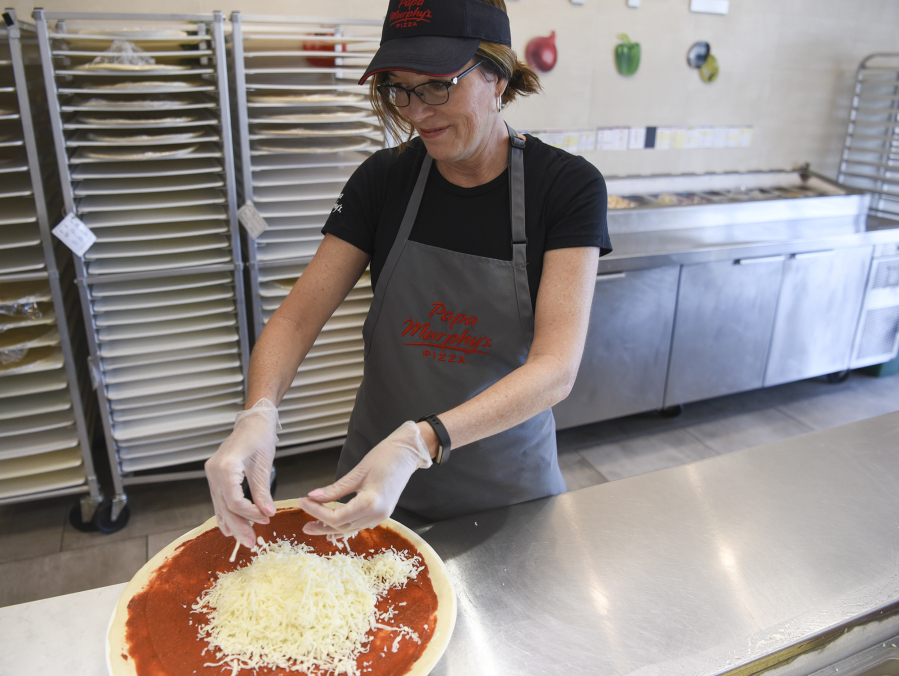Jean Birch slid behind a stainless steel counter at a Papa Murphy’s on East Mill Plain Boulevard with her hands in disposable gloves, ready to make some of the company’s famous take-and-bake pizzas.
Despite being the company’s top executive, she joked she probably wouldn’t pass for a good food prep. But she wasn’t exactly there to learn to make pies efficiently, though — she and 66 other top personnel from the pizza chain’s Vancouver headquarters were peppered around franchises for the day to work with the employees who are often impacted by boardroom decisions.
It’s a relationship that Birch and the company hope to reinforce as Papa Murphy’s looks to rebound from a tough year.
“It’s always good to ground yourself with where the business is,” she said. “As a franchisor, you own the brand and you need to be a good steward of the brand, but you can never lose sight of how much work it takes to run a good business.”
May 2 marked the three-year anniversary of Papa Murphy’s debut on the Nasdaq Exchange. The ride so far has appeared bumpier than expected and fallen short of some early goals for growth. The company has also become enmeshed in litigation with groups of franchisees, jettisoned some executive leadership, and may still be in the midst of a brand crisis.
But, for the day, Birch spent a few hours beside workers and franchise owner Brandon Lovelace, whose family joined the company decades ago when it was still called Papa Aldo’s.
“We got a little bit at odds over the last couple years, which is part of this (event), to be able to say ‘We know what business we’re in. We are in the franchising business,’ ” she said. “We don’t exist if they don’t exist.”
Key ingredients
The store, one of the Lovelace family’s 32 Washington franchises, is typical of a Papa Murphy’s: brightly colored, around 1,400 square feet — and quiet. The stores, without freezers or ovens, don’t have the clamor found in most pizza joints.
Lovelace, who helps oversee the stores with his dad, uncle and other business partners, started helping out at the store when he was 13 and became a store manager in college. He is hopeful for a turnaround this year. Sales have struggled since late 2015, when 19 consecutive quarters of growth ended. Since then, the company too often has posted quarters with headers featuring the word “disappointing.”
“Things were just really kicking for so long that when we had some harder times, it’s been a different reality,” he said. Since Birch arrived on the board March 2016, then interim CEO in December, he said franchisees feel “very encouraged with how things are heading.”
Where things went wrong gets varied answers, but people seem to agree on the ingredients.
Lovelace points to Papa Murphy’s going public in May 2014 and its aggressive pursuit of growth. It would do so in part by building and selling more franchises. The company planned to grow from 1,400 stores to 4,500, according to SEC filings.
However, the company has only grown from 1,461 stores to 1,577 since going public. Its franchises are located in the United States, Canada and the United Arab Emirates.
The pizza company also hoped to reach more consumers by expanding its menu to include new items, some of which were more expensive and some that were cheaper. Experts and franchisees said it was a way for the company to compete directly with cheaper, bigger pizza chains.
Some of those competitors are huge. According to the market research firm NPD Crest, Domino’s Pizza, Little Caesars Pizza, Papa John’s and Pizza Hut accounted for nearly 50 percent of the sales of the $38 billion pizza restaurant industry.
But Papa Murphy’s faltered when it took on the giants, Lovelace said. One instance: An online ordering promotion pushed heavily by a marketing executive hired from Domino’s led to computer system crashes and many irate customers on the phone.
“It felt like he kind of poisoned things a little bit,” he said. “Just not listening to the franchisee any longer, and he really had a game plan he wanted to see through without I think a great understanding of our business. It’s not just another pizza place, it’s not a Domino’s, it’s very much its own animal.”
Several executives ended up leaving the company in 2016, most notably Chairman John Barr and Chief Executive Officer Ken Calwell. Birch, who arrived in April 2015, became chairwoman after Barr’s departure and is filling the CEO position on the interim while a search for a permanent top executive is underway.
There was also a matter of litigation. Groups of franchise owners allege, among other things, that Papa Murphy’s defrauded them by misrepresenting them about the potential for success, according to court filings.
Birch, speaking about franchisees’ frustrations, said the company needed to change some of its blanket approaches to management.
“What’s the right thing for Portland might not be the right thing for Dallas, may not be the right thing for Jacksonville,” she said. “So how do we provide exactly what each market needs so that those owners in that market can be successful?”
Way of the future
Share prices for Papa Murphy’s Holdings Inc., traded as FRSH, debuted May 2014 at $11.05 per share and peaked June 2015 at $21.47. Then, from Jan. 1 of last year to Dec. 31, stock prices fell from $11 per share to $4.22. Share prices last week hovered around $5.
Competition, from both familiar faces and newcomers, is taking a huge bite of the company’s promise, according to one market analyst.
“Once they were THE take-and-bake pizza; today there’s a crowd,” said Darren Tristano, of the Chicago-based market research firm Technomic.
“It’s the market that’s driving performance, not brand or advertising,” he said. “The take-and-bake pizza at the supermarket, and now even brands like 7-Eleven and (Costco), has made it a lot harder to be successful in that space.”
He added that meal prep delivery services such as Blue Apron may even be taking away customers.
Advertising and marketing is playing a role for at least one successful pizza company. Domino’s Pizza spent millions of dollars in recent years to make it possible for customers to order online in easy, zany ways — like tweeting at a Domino’s pizza emoji. In 2015, more than half the company’s orders came online, according to Bloomberg.
In contrast, Papa Murphy’s hasn’t historically been a company hoping to win customers with marketing gimmicks or the lowest prices. By cutting out delivery drivers, ovens and freezers, the company could sell higher quality pizza at a more affordable price.
The pizza company recently tried to grow its presence, though. It launched a national television ad campaign called “Murphy’s Law,” pitching its pizza as the reliable dinner option when all other plans go awry. It aims to be a choice for parents.
“That is the core of who is going to stop to buy our pizza on their way home,” said Birch. “Mom’s still really feel like they’re responsible for providing dinner. It’s not that we don’t sell to everyone — we want everyone to buy — but that’s who we talk to.”
The commercials ran for six weeks, but Birch said in an earnings report Wednesday she felt “disappointed” by its returns. The company’s first earnings report of 2017 showed a $5.4 million loss, fueled largely by the cost of the ad and severance pay for now-fired executives.
“We learned a lot from the process,” she said of the ad. “You want to make sure for what you invest you get a return on that investment. We’re in that final analysis; we don’t have all the answers yet. I personally thought it should do more for what we spent.”
Papa Murphy’s will look into some new delivery options, however. The company announced in April a partnership with Amazon Restaurants to allow Amazon Prime members in Portland and Seattle to hire drivers to pick up and deliver their pizza.
The company also hopes to add 75 more stores in 2017.





